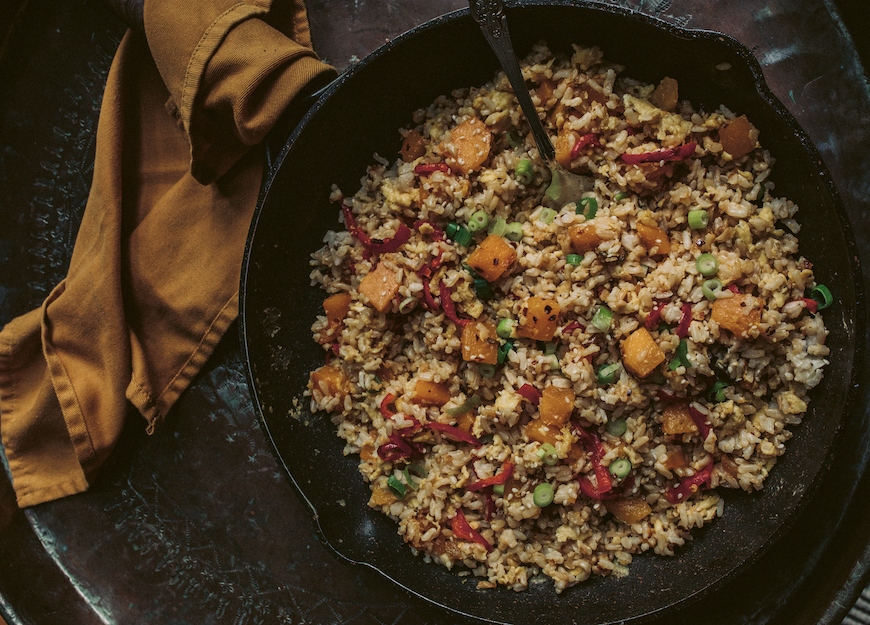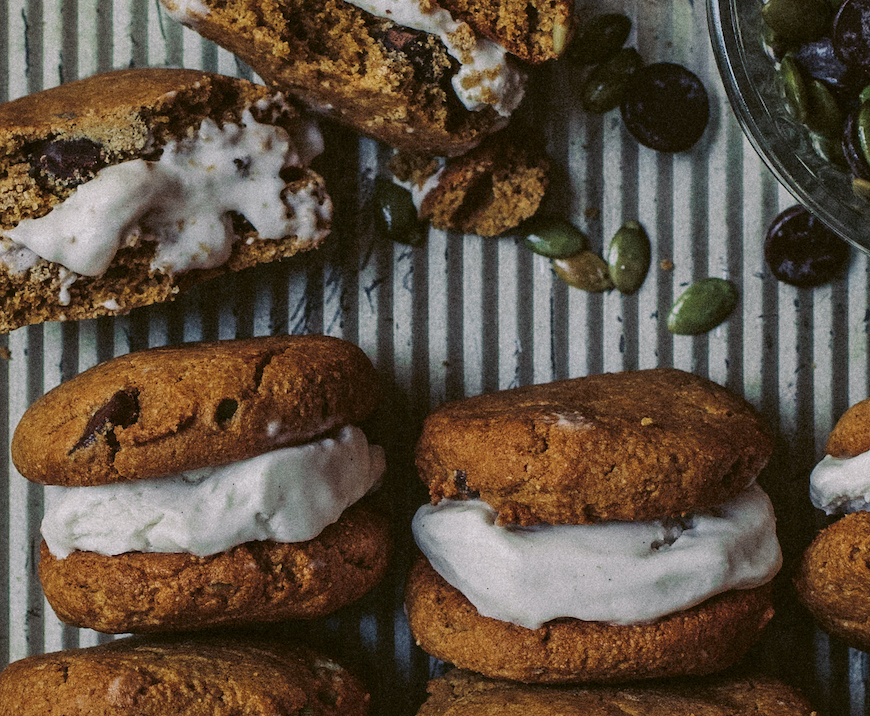These 3 Delicious, Nutrient-Rich Recipes Help Support Your Hormonal Cycle
Developing delicious recipes that support your hormonal cycle is something Moon Cycle Bakery founder Devon Loftus has devoted her professional life to educating people about. Moon Cycle Bakery focuses on creating food products that support people hormonally, spiritually, and emotionally. You want a brownie? Theirs are made with sweet potato and dark chocolate chunks. The sweet potato is high in vitamin B6, which plays a role in synthesizing dopamine and serotonin in the brain, lessening feelings of depression or irritability. And I think we can all agree that dark chocolate is linked to boosting your mood, too.
- Devon Loftus, Devon Loftus is the founder of Moon Cycle Bakery, which focuses on creating food products that support people hormonally, spiritually, and emotionally. She is the co-author of the book Moon Cycle Cookbook.
- Jenna Radomski, MScN, Jenna Radomski, MScN, is a holistic nutritionist and the co-author of the Moon Cycle Cookbook.
Watch the video below to learn more about foods that support the menstrual cycle:
Recently, Loftus teamed up with holistic nutritionist Jenna Radomski, MScN, to write the first-ever Moon Cycle Cookbook ($19). Each recipe is formulated with insider-intel of what's happening hormonally in the body during each cycle phase, using ingredients that replenish and support essential nutrients.
Besides incredible, mouth-watering recipes, the book also includes ideas for rituals to do during each moon cycle phase. "I wanted this cookbook to bring a sense of stillness and warmth, like sitting down with an old friend over a cup of tea—a book that not only supported people physically with education and recipes, but a book that left them feeling nourished in an emotional sense, as well," Loftus says. "For us, this meant suggesting rituals and easy, accessible practices that they could integrate into their month as they ebb and flow. We find the rituals to be our way of acknowledging the whole self and encouraging others to be curious about the ways they can reconnect with their own rhythms."

{{post.sponsorText}}
Come for the rituals and stay for the food. Here, Loftus and Radomski share three recipes from the Moon Cycle Cookbook, explaining how each one supports the menstruating body.

Raspberry lavender lemon chia jam recipe
Not only does this jam satisfy the craving for something sweet, Radomski says it supports good digestion—something that many people find is disrupted before and during their cycle. "Chia seeds are a good source of soluble fiber, which is a type of fiber found in plants that is water-soluble," she explains. "When mixed with a liquid, soluble fiber begins to break down and creates a gel-like texture that slows digestion by binding extra water in the intestinal tract and thickens our stool."
Additionally, Radomski says the raspberries are a good source of B vitamins, which support the natural production of serotonin. "Vitamin B6, in particular, is needed for the production of progesterone, the sex hormone that ramps up during the luteal phase [the stage after ovulation and before your period starts]," she says.
Ingredients
3 cups raspberries, fresh or frozen
1/4 cup water
2 Tbsp pure maple syrup
1 Tbsp dried lavender flowers
2 tsp lemon juice
1 1/2 tsp lemon zest
2 Tbsp chia seeds
1. Combine the raspberries and water in a small saucepan and place over medium heat. Bring the mixture to a boil, using a wooden spoon to stir frequently and mash the berries, then reduce the heat to low. Add the maple syrup, lavender, lemon juice, and lemon zest, and stir well. Simmer for 10 minutes, uncovered, stirring occasionally.
2. Remove the pan from the heat and stir in the chia seeds. Pour the jam into a glass jar or container and let cool to room temperature before sealing with a lid and placing in the refrigerator. Chill for three to four hours before serving to allow the jam to set. The jam will keep in the refrigerator for up to one month.

Chili-mango fried rice bowl with sesame seeds recipe
Radomski says that there are two main ingredients that make this fried rice especially supportive during the luteal phase: brown rice and sesame seeds. "Brown rice is a gluten-free grain that is a rich source of complex carbohydrates, magnesium, calcium, and vitamin B6, which are all nutrients we recommend focusing on for the luteal phase," she says. "Sesame seeds are a great source of magnesium and calcium, two minerals that can help reduce fluid retention, constipation, and headaches—all common PMS symptoms that often show up in the luteal phase."
She explains that during the luteal phase, it's common for people to experience increased appetite and cravings for carbohydrates. This, she says, is because progesterone stimulates our appetite. "[This dish] gives people permission to honor those cravings while nourishing their bodies with whole, nutrient-dense foods," she says.
Ingredients
11/2 cups brown rice
3 cups vegetable or chicken broth
1 Tbsp avocado oil
2 medium mangoes, peeled and diced
1 medium red bell pepper, sliced
4 scallions, thinly sliced
2 Tbsp liquid aminos or coconut aminos
1 Tbsp red pepper flakes
4 eggs
1/4 cup sesame seeds
1. Combine the rice and broth in a medium saucepan and bring to a boil over high heat. Reduce the heat to low, cover, and simmer for 35 to 45 minutes, or until the rice is tender and the liquid is absorbed. Alternatively, combine the rice and broth in a rice cooker and cook according to the manufacturer’s directions. Transfer the cooked rice to a large bowl and chill in the refrigerator for at least one hour or overnight.
2. Heat the oil in a large skillet over medium-high heat. Add the mangoes, bell pepper, and scallions, and sauté until lightly browned, three to five minutes. Add the chilled rice, liquid aminos, and pepper flakes, and sauté for five minutes, mixing occasionally.
3. Crack the eggs into a small bowl and whisk until uniform in color. Move the rice mixture to one side of the saucepan and gently pour the eggs into the other side. Cook, stirring frequently with a silicone spatula, until the eggs begin to come together, three to four minutes. Combine the eggs with the rice mixture and cook for one minute longer. Remove from the heat, stir in sesame seeds, and serve immediately. Store leftovers in an airtight container in the refrigerator for three to four days.

Pumpkin-chocolate chip ice-cream sandwiches recipe
Pumpkin, Loftus and Radomski explain in the cookbook, is very supporting during the luteal phase because it's a good source of soluble fiber, complex carbs, vitamin B6, and zinc. Additionally, they say the oat flour in this recipe adds soluble fiber-rich whole grains, which help with progesterone and serotonin production.
When following this recipe, Radomski says it's important to use pumpkin purée, not pumpkin pie filling. "Pumpkin purée's only ingredient is pumpkin, while pumpkin pie filling already has salt, sugar, spices, and natural flavors added to it, which would alter these cookies," she says. She also says the cookies can be delicious to have on their own; the ice cream is totally optional (but highly encouraged).
Ingredients
1 3/4 cups oat flour
1/4 cup coconut flour
1 tsp ground cinnamon
1 tsp kosher salt
3/4 tsp baking powder
1/2 tsp baking soda
1/2 tsp ground nutmeg
1/4 tsp ground ginger
1/2 cup pumpkin purée (not pumpkin pie filling)
1/3 cup pure maple syrup
1/4 cup coconut oil, melted
3 Tbsp salted cashew butter
1 1/2 tsp vanilla extract
1/3 cup dark chocolate chips (70 percent cacao or higher)
1/3 cup raw pumpkin seeds (pepitas), roughly chopped
1 pint vanilla or chocolate ice cream (dairy or dairy-free)
1. Preheat the oven to 350°F. Line two large baking sheets with parchment paper or silicone baking mats. Set aside.
2. Whisk together the oat flour, coconut flour, cinnamon, salt, baking powder, baking soda, nutmeg, and ginger in a large mixing bowl until combined.
3. Combine the pumpkin, maple syrup, oil, cashew butter, and vanilla in a medium mixing bowl and whisk until smooth. Pour into the flour mixture and stir with a spatula until just combined (overmixing results in dense cookies). Gently fold in the chocolate chips and pumpkin seeds.
4. Scoop out about two tablespoons of the dough and roll it between your hands to form a ball. Place on a prepared baking sheet. Repeat until you have 20 balls (add any extra dough to your smallest cookies), placing them about two inches apart on the baking sheets. Using the palm of your hand, flatten the cookies to 1/4-inch thickness.
5. Bake the cookies for 18 minutes, or until the edges are golden brown. Transfer the cookies to a wire rack and cool for about 15 minutes.
6. Add three tablespoons of ice cream to the flat side of a cookie and gently place another cookie on top, flat-side down. Gently press on the sandwich with your palms. Repeat with the remaining cookies and ice cream and serve immediately. Store the ice cream and cookies separately. The cookies will keep in an airtight container at room temperature for about one week.
Excerpted from The Moon Cycle Cookbook (c) by Devon Loftus and Jenna Radomski, photography (c) by Poppi Photography, used with permission from Storey Publishing.
Get more recipe ideas in Well+Good's Cook With Us Facebook group.
Loading More Posts...